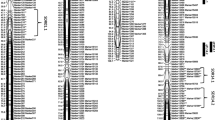Abstract
The fiber length trait (FLT) of 538 individuals from nature birch population in Maorshan region, Heilongjang, China were measured, of which 100 individuals were selected as representative variety of correlated fragments screening with random amplified polymorphism DNA (RAPD) technique. In total of 20 RAPD primers were tested through multiple regression analysis between amplified strip and the character behaviors, and a correlative segment BFLR-16 was obtained. The correlation coefficient between BFLI-16 and FLT was 0.6144, with the significant level of 1%. BFLI-16 was then cloned, sequenced and transformed into SCAR marker. The percentage of identifying long fiber birches by this SCAR was more than 92. The result indicates that the SCAR markers has high specificity for the long fiber individuals and is highly linked with the gene controlling the character of fiber length, and its existence is significantly correlative with the increase in the fiber length.
Similar content being viewed by others

References
Cervera MT, Storme V, Ivens B, Gusmao J, Liu BH, Hostyn V, van Slycken J, van Montagu M, Boerjan W. 2001. Dense genetic linkage maps of three populus species (Populus deltoides, P. nigra and P. trichocarpa) based on AFLP and microsatellite markers. Genetics, 158(2): 787–809.
Garcia GM. 1996. Identification of RAPD, SCAR and RFLP markers tightly linked to nematode resistance genes introgressed from Arachis cardenasii into Arachis hypogaea. Genome, 39(5): 836–845.
Grattapaglia D, Sederoff R. 1994. Genetic linkage maps of Eucalyptus Grandis and Eucalytus urophy using a Pseudo-testcross mapping strategy and RAPD marker. Genetics, 137(4): 1121–1137.
Jermstad KD, Bassoni DL, Jech KS, Wheeler NC, Ritchie GA, Neale DB. 2003. Mapping of quantitative trait loci controlling adaptive traits in coastal Douglas-fir III.QTL trait loci-by-environment interactions. Genetics, 165(3):1489–1506.
Li Ping, Fang Guiping, Sun Chengzhi. 1995. Wood characteristics of pulpwood. Chemistry and Industry of Forest Products, 15(Suppl): 13–18.(in Chinese)
Meletto M. 1996. Development of a SCAR marker linked to the gene in common bean. Genome, 39(6): 1216–1219.
Ohmori T. 1996. Molecular characterization of RAPD and SCAR markers linked to the Tm-1 locus in tomato. Theoretical and Applied Genetics, 92(2):151–156.
Shi Jiang, Xin Li, Tan Lin, Zheng Xueqin. 2007. Study on the RAPD specific band of Kava (Piper, Piperaceae) transferring to the SCAR molecular marker. Acta Botanica Yunnanica, 29(4): 457–460. (in Chinese)
Tang Meiling, Kong Jin, Xu Xuefeng, Shen Yujie, Wang Yi, Li Tianzhong, Han Zhenghai. 2008. Screening of the AFLPM markers associated to the sex locus of Vitis amurensis Rupr and its conversion to SCAR marker. Acta Horticulturae Sinica, 35(2): 195–200. (in Chinese)
Wu RL, Han HF, Hu JJ, Fang JJ, Li L, Li ML, Zeng ZB. 2000. An integrated genetic map of Populus deltoids based on amplified fragment length polymorphisms. Theoretical and Applied Genetics, 100(8): 1249–1256
Xu Yunbi, Zhu Lihuang. 1994. The application of molecular quantitative genetics. Beijing: China Agriculture Press, pp.112–115. (in Chinese)
Xu Jichen, Zou Liangxing. 2002. Identification of molecular markers associated with rice root traits by correlation coefficient analysis. Acta Genetica Sinica, 29(3): 245–249. (in Chinese)
Zeng Changying, Xu Fangsen, Meng Jinling, Wang Yunhua, Hu Chenxiao. 2006. How long the way from QTL to QTGs? Hereditas, 28(9): 1191–1198.
Zhang Bo, Du Mingsheng, Huang Minren. 2003. Status quo and tendency in construction of forest frees’ genetic linkage maps. China Biotechnology, 23(4): 14–18.(in Chinese)
Zhan Yaguang, Zeng Fansuo. 2005. A method for DNA extraction from mature birch leaves rich in polysaccharid. Journal of Northeast Forestry University, 33(3): 24–25.(in Chinese)
Zhang Zhiyi, Lin Shanzhi, Zhang Deqiang, Zhang Qian. 2002. Applications of modern molecular biotechnology to genetic improvement in forest trees. Journal of Beijing Forestry University, 23(4): 250–261.(in Chinese)
Author information
Authors and Affiliations
Corresponding author
Additional information
Foundation project: This study was supported by the National 863 Program (2002BA515B0401), National Natural Science Foundation of China (30571513) and Foundation of Heilongjiang Province (GA06B301)
Rights and permissions
About this article
Cite this article
Wang, D., Wei, Zg., Yang, Cp. et al. Analysis and identification of SCAR molecular markers associated with birch fiber length trait. Journal of Forestry Research 19, 288–292 (2008). https://doi.org/10.1007/s11676-008-0051-2
Received:
Accepted:
Published:
Issue Date:
DOI: https://doi.org/10.1007/s11676-008-0051-2



